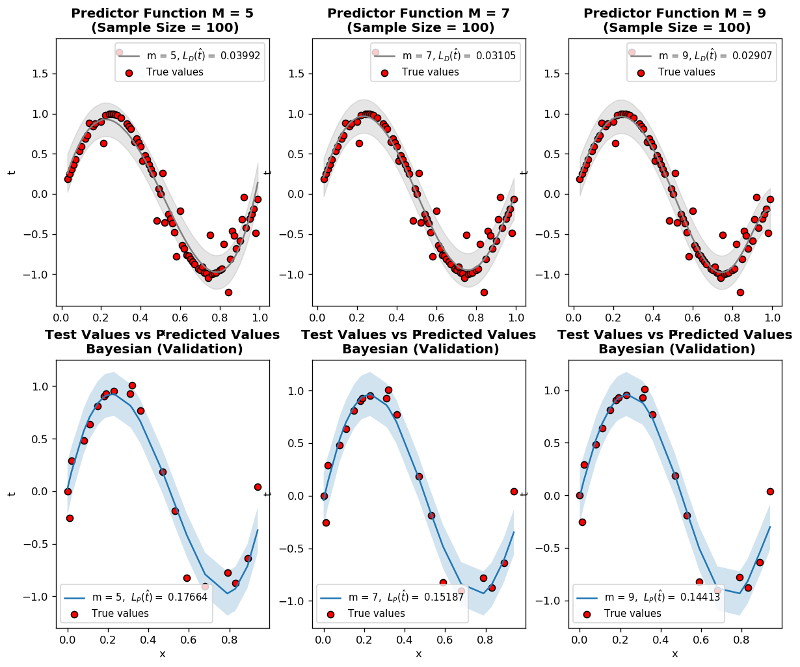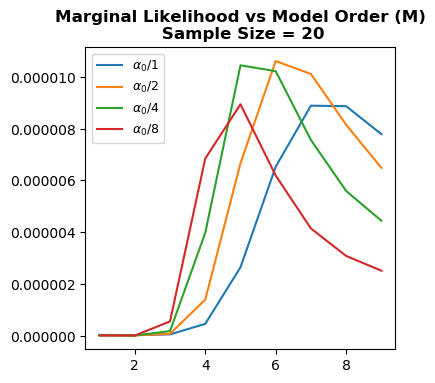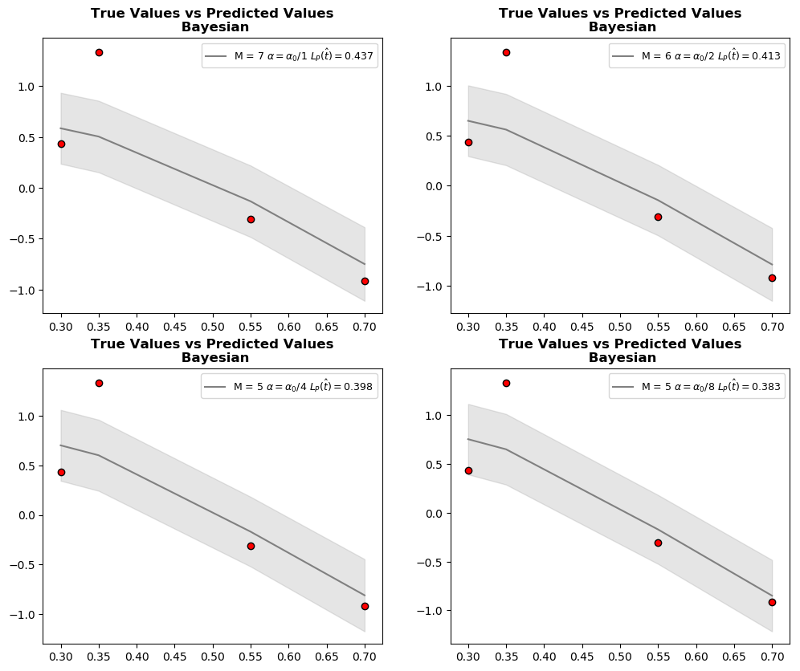A Brief Introduction to Machine Learning for Engineers 2 Part III
 |
 |
2. A “Gentle” Introduction Through Linear Regression
2.4 Bayesian framework:
In frequentist framework, there are 2 distributions: true distribution approximated by empirical distribution and model distribution. However, in bayesian framework:
- All data points are jointly distributed
- Model parameters are also jointly distributed
At the end, bayesian framework considers all \(\theta\) values weighted with respect to data dependent belief. In short, everything is a random variable.
As a result, we have \(P(t_{D},w,t \vert X_{D}, x)\) as a posterior distribution. Given data set and a new point \((\mathcal{D},x)\), \(P(t \vert t_{D}, X_{D}, x) = P(t \vert \mathcal{D},x)\) is found using marginalization of \(P(t, w, t_{D} \vert X_{D}, x)\).
Using posterior \(P(t \vert \mathcal{D},x)\), predictor can be evaluated \(\hat{t}\). In a true bayesian framework, we have the explicit formula of the distribution function. By ignoring the domain points, we have
\[P(t, w, t_{D}) = \underset{\text{prior}}{P(w)} ~~ \underset{\text{likelihood}}{P(t_{D}~ \vert w)} ~~~ \underset{\text{distribution of new data}}{P(t \vert x)}\]As a clarification, this equation holds due to the conditional independence of \({\rm t} ~ \vert {\rm w}\) and \({\rm t_{D}} ~ \vert {\rm w}\) as shown in the Figure 2.7 (book). In words, knowing only parameter w and \(t_{D}\) doesn’t give information about \(t\).
As mentioned our main purpose it to find \(P(t \vert \mathcal{D},x)\) and again dropping data points, we have
\[P(t \vert T_{D}) = \frac{P(t, T_{D})}{P(T_{D})} = \underset{\text{marginalization}}{\frac{\int P(t,w, T_{D})dw}{P(T_{D})}} = \frac{\int P(t, T_{D} \vert w) P(w) dw }{P(T_{D})}\] \[P(t \vert T_{D}) = \int P(t \vert w) ~ \left( \underset{\text{Bayes' rule}}{ \frac{P(T_{D} \vert w) P(w) }{P(T_{D})}} ~ \right) dw = \int P(t \vert w) P(w \vert T_{D}) dw\]Finally reintroducing the data points, we obtain the key equation which is bayes prediction function
\[P(t \vert T_{D},x ) = \int P(t \vert x, w) P(w \vert \mathcal{D}) dw\]Computing the posterior \(P(w \vert \mathcal{D})\) and predictive distribution \(P(t \vert x, w)\) is a difficult task. Especially in higher dimensions integrating out the model parameters becomes easily intractable. Using Gaussian prior \(\mathcal{N}(w \vert 0, \alpha^{-1})\), distribution of new data \(\mathcal{N}(t \vert \mathcal{M}(x,w), \beta^{-1})\) and likelihood \(\prod_{n=1}^{N} \mathcal{N}(t_{n} \vert \mathcal{M}(x,w), \beta^{-1})\), we can find predictive function distribution as
\[{\rm t} \vert {\rm x} \sim \mathcal{N}(t \vert \mathcal{M}(x,w_{MAP}~), S^{2}(x)) ~~~~ (2.36)\]In this equation, \(S^{2}(x) = \beta^{-1} [ 1 + \phi(x)^{T} ( \lambda I + X_{D}^{T} X_{D})^{-1} \phi(x)]\). However, deriving this equation is an extremely tedious task which also fortifies the claim about the difficulty of integration process. A detailed step by step derivation can be found in mathematicalmonk’s videos here (watching him struggle might also produce a confidence boost).
ML and MAP vs bayesian
Comparing the returned distribution of each approach, it is easy to see distinction
- ML: \(\mathcal{N}(t \vert \mathcal{M}(x,w_{ML}~), \beta^{-1}(x))\)
- MAP: \(\mathcal{N}(t \vert \mathcal{M}(x,w_{MAP}~), \beta^{-1}(x))\)
- Bayesian: \(\mathcal{N}(t \vert \mathcal{M}(x,w_{MAP}~), S^{2}(x))\), variance changes with w.r.t. x
In bayesian approach, variance changes with given new data point. In addition, as \(N \to \infty, S^{2}(x) \to 1 / \beta\)
Bayesian code practice
- N is the sample size
- \(\mathcal{L}_{D}~(\hat{t})\) is training loss
- \(\mathcal{L}_{P}~(\hat{t})\) is generalization loss which is approximated by validation using Root Mean Squared Metric
- \(\lambda\) is regularization constant
Observations:
-
lambdis the regularization constant and dictates how much our predictor \(\hat{t}\) fluctuates. Trylambd=10**-5andlambd=10**-1to see how it limits the function even for \(M=9\) -
Even for small sample size
N=15, MAP prevents overfitting of \(M=9\) -
When sample size
N=600and more, ML and MAP start to converge to the same results.
%matplotlib inline
import math
import numpy as np
import pandas as pd
import matplotlib.pyplot as plt
from scipy import stats, linalg
N = 100 # sample size
M = 9 # model order
domain_range = 1 # range of x values
alpha = 10**-2
beta = 10
def t_true(x):
return np.sin(2 * np.pi * x)
def fi(x, M):
return np.array([x**i for i in range(0, M + 1)])
def data_generator(N, test_ratio=0.3):
np.random.seed(42) # To obtain the same result
train_ratio = 1 - test_ratio
limit_index = math.floor(N * train_ratio)
nonoutlier_ratio = math.ceil(N * 0.7)
X = np.linspace(0, domain_range, N, endpoint=False)
nonoutlier_index = np.random.choice(X.shape[0], nonoutlier_ratio, replace=False)
noise = np.array(stats.norm.rvs(loc=0, scale=0.35, size=N))
noise[nonoutlier_index] = 0
t = t_true(X) + noise
# Randomization of dataset
index = np.random.choice(X.shape[0], X.shape[0], replace=False)
X = X[index]
t = t[index]
X_test = X[limit_index: None]
X_train = X[: limit_index]
t_test = t[limit_index: None]
t_train = t[: limit_index]
print(f" Training size: {X_train.shape[0]} and test size: {X_test.shape[0]}")
return X_train, t_train, X_test, t_test
def design_matrix(X, m):
Xd = np.array([fi(x, m) for x in X])
return Xd
def predic_bayesian(X_train,t_train,m,x):
Xd = design_matrix(X_train, m)
Fd = design_matrix(x, m)
A = linalg.inv((alpha/beta) * np.identity(m + 1) + np.matmul(Xd.T, Xd))
Xpenrose = np.matmul(A, Xd.T)
w = np.matmul(Xpenrose, t_train)
t_predic = np.matmul(Fd, w)
t_variance = beta**-1 * (1 + np.diagonal(np.matmul(np.matmul(Fd,A) ,Fd.T )))
return t_predic, t_variance
def rms_calculator(t1, t2):
""" L_P(t): Generalization loss"""
result = np.sqrt(np.sum((t1 - t2)**2) / len(t1))
result = round(result, 5)
return result
def training_loss(t1, t2):
""" L_D(t): Training loss"""
result = np.sum((t1 - t2)**2) / len(t1)
result = round(result, 5)
return result
X_train, t_train, X_test, t_test = data_generator(N, test_ratio=0.2)
# print(X_train, t_train, X_test, t_test)
fig, ax = plt.subplots(nrows=2, ncols=3, figsize=(12, 10), dpi=120)
print(ax.shape)
count = 0
for m in [5, 7, 9]:
### Bayesian learning
t_predic, t_variance = predic_bayesian(X_train,t_train,m,X_test)
t_predic_train, t_variance_train = predic_bayesian(X_train,t_train,m,X_train)
L_dt = training_loss(t_train, t_predic_train)
RMS = rms_calculator(t_test, t_predic)
order = np.argsort(X_train)
ax[0][count].plot(X_train[order], t_predic_train[order],\
'-', color='gray', label=f"m = {m}, " + r"$$L_{D}(\hat{t}) = $$" + f" {L_dt}")
ax[0][count].fill_between(X_train[order], t_predic_train[order] - 2*t_variance_train[order], \
t_predic_train[order] + 2*t_variance_train[order], color='gray', alpha=0.2)
ax[0][count].set_title(f"Predictor Function M = {m}\n (Sample Size = {N})", fontweight="bold")
ax[0][count].set_xlabel("x")
ax[0][count].set_ylabel("t")
order = np.argsort(X_train)
ax[0][count].scatter(X_train[order], t_train[order], label=f"True values", marker="o", facecolor="r", edgecolor="k")
ax[0][count].legend(fontsize=9)
order = np.argsort(X_test)
ax[1][count].plot(X_test[order], t_predic[order], '-', label=f"m = {m}, " + r" $$L_{P}(\hat{t}) = $$" + f" {RMS}")
ax[1][count].fill_between(X_test[order], t_predic[order] - 2*t_variance[order], \
t_predic[order] + 2*t_variance[order], alpha=0.2)
order = np.argsort(X_test)
ax[1][count].set_title(f"Test Values vs Predicted Values\n Bayesian (Validation)", fontweight="bold")
ax[1][count].scatter(X_test[order], t_test[order], label=f"True values", marker="o", facecolor="r", edgecolor="k")
ax[1][count].legend(fontsize=9)
ax[1][count].set_xlabel("x")
ax[1][count].set_ylabel("t")
count += 1
# plt.savefig('map_results_1.png')
plt.show()
 |
Marginal likelihood
Following formula is named marginal log likelihood
\[P(t_{D}~ \vert X_{D}) = \int P(w) \prod_{n=1}{N} P(t_{n}~ \vert x_{n},w) dw\]and this approach enables model selection without validation by including prior information to likelihood process. Calculating the marginal likelihood of running example:
\[P(t_{D}~ \vert X_{D}) \sim \mathcal{N}(0, \alpha^{-1} X_{D}~X_{D}^{T} + \beta^{-1} I )\]Since normalization constant of a Gaussian distribution depends on variance which \(\alpha^{-1} X_{D}~X_{D}^{T} + \beta^{-1} I\), peak value of \(P(t_{D}~ \vert X_{D})\) changes with \(\alpha\) and \(\beta\) parameters.
Let’s go through the whole process. At first, we choose \(\alpha, \beta\) and calculate marginal log likelihood \(P(t_{D}~ \vert X_{D})\) and choose the \(M\) yielding peak value. However, if we graph \(P(t_{D}~ \vert X_{D})\) vs. \(M\) with different \(\alpha\) values, it is clear that even though peak \(M\) values are similar we cannot exactly pin down the optimum value with only checking a single \(\alpha\). In short, we again have a hyperparameter to tune. As we mentioned earlier, changing \(\alpha\) affects variance \(alpha^{-1} X_{D}~X_{D}^{T} + \beta^{-1} I\) which changes normalization and consequently peak value of \(P(t_{D}~ \vert X_{D})\).
Finally, assigning priors to \(\alpha\) and \(M\) also leads to hierarchical models that will be covered in post 7.
Marginal likelihood code practice
- \(\mathcal{L}_{P}~(\hat{t})\) is generalization loss which is approximated by validation using Root Mean Squared Metric
- \(\alpha\) is precision for w
- \(\beta\) is precision for data points
Observations:
- Change the
alpha=10**-1, 10**-2, 10**-3and see how optimum model order \(M\) changes. - Even though optimum model order is the same for constant
alpha, in certain values such asalpha=10**-1andN=20, marginal likelihood peaks at different model orders.
%matplotlib inline
import math
import numpy as np
import pandas as pd
import matplotlib.pyplot as plt
from scipy import stats, linalg
N = 20 # sample size
M = 9 # model order
alpha = 10**-1
beta = 10
domain_range = 1
def t_true(x):
return np.sin(2 * np.pi * x)
def fi(x, M):
return np.array([x**i for i in range(0, M + 1)])
def data_generator(N, test_ratio=0.3):
np.random.seed(42) # To obtain the same result
train_ratio = 1 - test_ratio
limit_index = math.floor(N * train_ratio)
nonoutlier_ratio = math.ceil(N * 0.7)
X = np.linspace(0, domain_range, N, endpoint=False)
nonoutlier_index = np.random.choice(X.shape[0], nonoutlier_ratio, replace=False)
noise = np.array(stats.norm.rvs(loc=0, scale=0.35, size=N))
noise[nonoutlier_index] = 0
t = t_true(X) + noise
# Randomization of dataset
index = np.random.choice(X.shape[0], X.shape[0], replace=False)
X = X[index]
t = t[index]
X_test = X[limit_index: None]
X_train = X[: limit_index]
t_test = t[limit_index: None]
t_train = t[: limit_index]
print(f" Training size: {X_train.shape[0]} and test size: {X_test.shape[0]}")
return X_train, t_train, X_test, t_test
def design_matrix(X, m):
Xd = []
for x in X:
Xd.append(fi(x, m))
Xd = np.array(Xd)
return Xd
def predic_bayesian(X_train,t_train,m,x):
Xd = design_matrix(X_train, m)
Fd = design_matrix(x, m)
A = linalg.inv((alpha/beta) * np.identity(m + 1) + np.matmul(Xd.T, Xd))
Xpenrose = np.matmul(A, Xd.T)
w = np.matmul(Xpenrose, t_train)
t_predic = np.matmul(Fd, w)
t_variance = beta**-1 * (1 + np.diagonal(np.matmul(np.matmul(Fd,A) ,Fd.T )))
return t_predic, t_variance
def marginal_likelihood(alpha, beta, X):
result = []
optimum_M = 0
mml = 0
for m in range(1, M + 1):
Xd = design_matrix(X, m)
variance = (1 / alpha) * np.matmul(Xd, Xd.T) + (1 / beta) * (np.identity(Xd.shape[0]))
# variance = np.linalg.inv(variance)
current_mml = stats.multivariate_normal.pdf(t_train, mean=None, cov=variance)
if current_mml > mml:
mml = current_mml
optimum_m = m
result.append(current_mml)
return result, optimum_m
X_train, t_train, X_test, t_test = data_generator(N, 0.2)
fig1, ax = plt.subplots(1,1, figsize=(4,4), dpi=100)
fig2, bx = plt.subplots(nrows=2, ncols=2, figsize=(12, 10), dpi=100)
count = 0
for current_ax in bx.reshape(-1):
alpha = alpha / (2**(count))
result, optimum_m = marginal_likelihood(alpha, beta, X_train)
ax.plot([m for m in range(1, M + 1)], result, label=r"$$\alpha_{0}$$" + f"/{2**count}")
t_predic, t_variance = predic_bayesian(X_train,t_train,optimum_m,X_test)
RMS = round(np.sqrt(np.sum((t_test - t_predic)**2) / len(t_predic)), 3)
order = np.argsort(X_test)
current_ax.plot(X_test[order], t_predic[order], color="gray",label=f"M = {optimum_m} " + r"$$\alpha = \alpha_{0}$$" + f"/{2**count} " + r"$$ L_{P}(\hat{t})=$$" + f"{RMS}")
current_ax.fill_between(X_test[order], t_predic[order] - 3*t_variance[order], \
t_predic[order] + 3*t_variance[order], color="gray",alpha=0.2)
current_ax.legend(fontsize=9)
current_ax.set_title("True Values vs Predicted Values\n Bayesian", fontweight="bold")
current_ax.scatter(X_test, t_test, label="True distribution", facecolor="r", edgecolor="k")
alpha = alpha * 2**(count)
count += 1
ax.set_title(f"Marginal Likelihood vs Model Order (M)\n Sample Size = {N}", fontweight="bold")
ax.legend(fontsize=9)
plt.show()
 |
 |
| Previous post: Chapter 2: Part II |